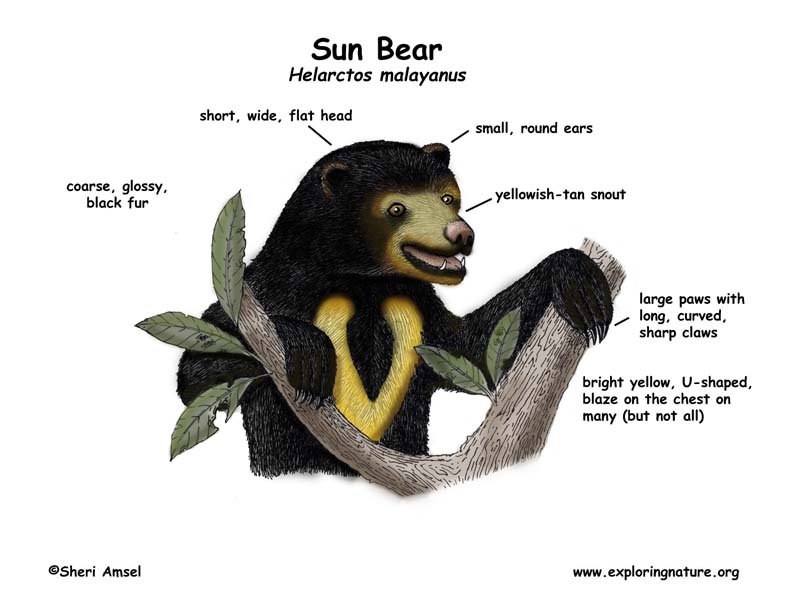

They are found in Asia from the Himalayas to China, Burma, Indochina and the Malayan peninsula.
They live in dense, tropical rainforests.
They are the smallest bear, weighing only up to 150 pound (64 kg) and reaching 4 feet long. Females are slightly smaller. They are all black with a yellowish snout and u-shaped blaze on the chest. They have small ears and a wide, flat head. They have large paws with long, curved claws. Their limbs turn in, giving them a seemingly “pigeon-toed” walk. They have long flexible tongues that they can use to fish out termites or honey from hives.
They can climb trees (arboreal) and are often found in them sleeping or basking in the sun. They are active at night (nocturnal). They do not hibernate.
They are omnivores, eating insects ¬– like bees, ants and termites, fruits, honey, eggs, small animals (lizards, rodents and birds), and even dead animals (carrion).
Cubs may be killed by tigers, but adults have few predators except humans.
Females are pregnant for about 3 months (gestation) and have 1-3 young. Like other bear species, sun bears may experience delayed implantation where they mate but do not become pregnant until later, so births are timed with better food abundance or climate. The cubs stay with their mother for up to 3 years before going out on their own.
They can live for about 25 years. Their numbers are declining from hunting and habitat destruction.
Kingdom: Animalia
Phylum: Chordata
Subphylum: Vertebrata
Class: Mammalia
Order: Carnivora
Suborder: Caniformia
Family: Ursidae
Genus: Helarctos
Species: H. malayanus
When you research information you must cite the reference. Citing for websites is different from citing from books, magazines and periodicals. The style of citing shown here is from the MLA Style Citations (Modern Language Association).
When citing a WEBSITE the general format is as follows.
Author Last Name, First Name(s). "Title: Subtitle of Part of Web Page, if appropriate." Title: Subtitle: Section of Page if appropriate. Sponsoring/Publishing Agency, If Given. Additional significant descriptive information. Date of Electronic Publication or other Date, such as Last Updated. Day Month Year of access < URL >.
Amsel, Sheri. "Bear (Sun)" Exploring Nature Educational Resource ©2005-2024. December 13, 2024
< http://www.exploringnature.org/db/view/Bear-Sun >

